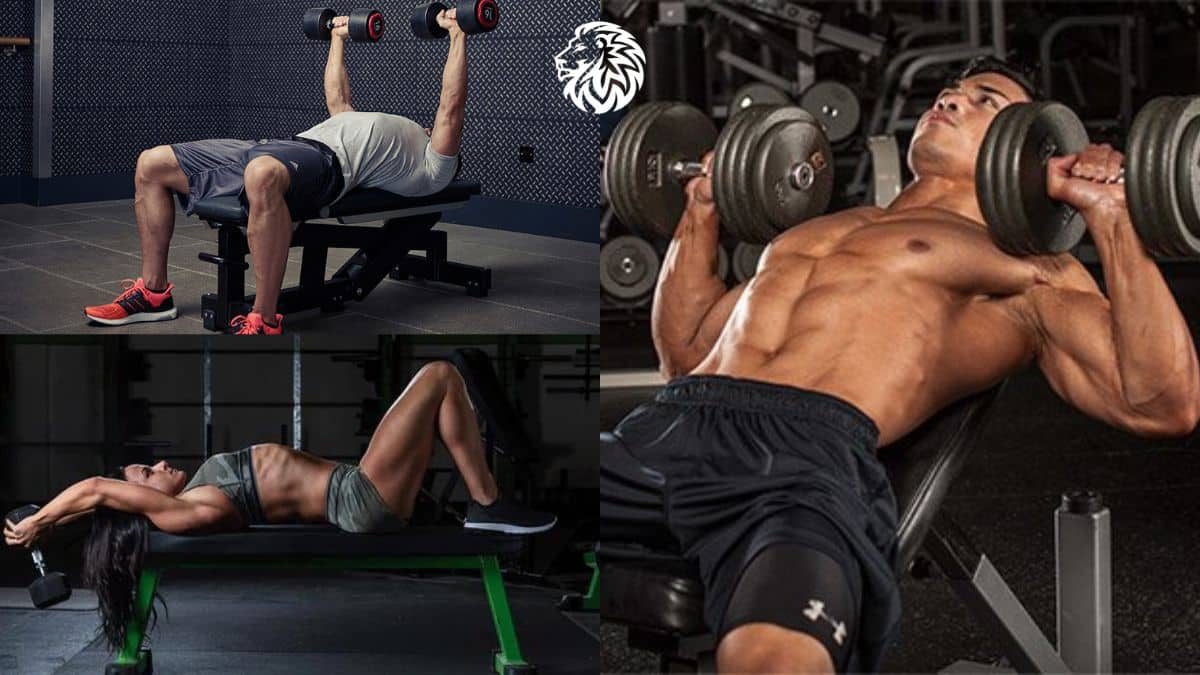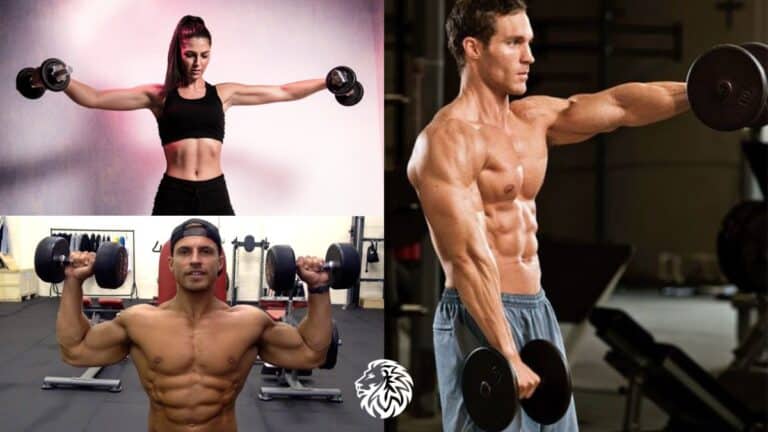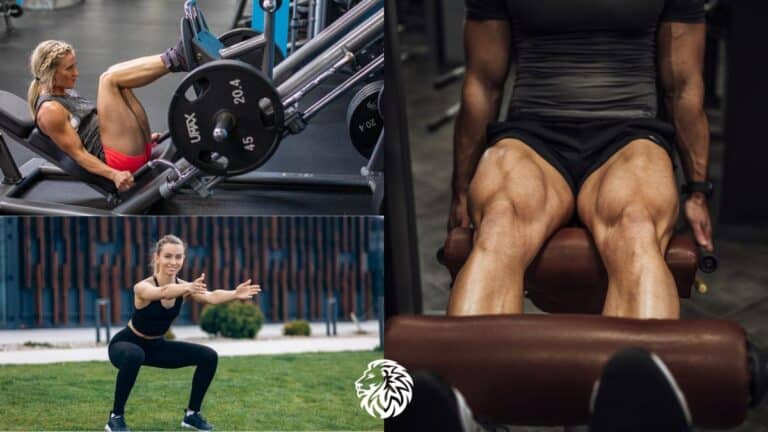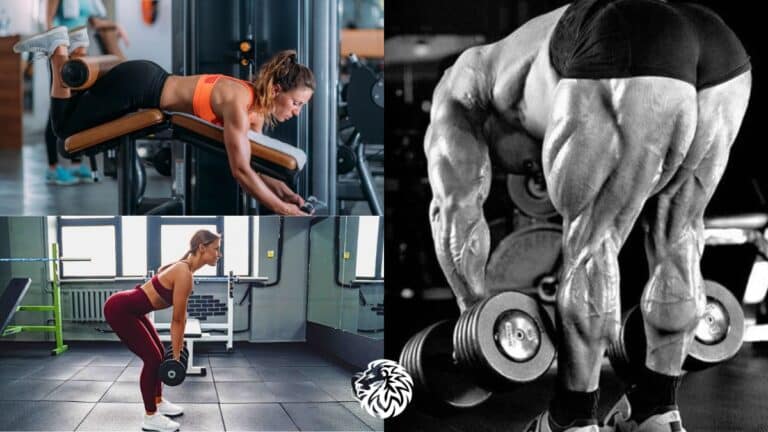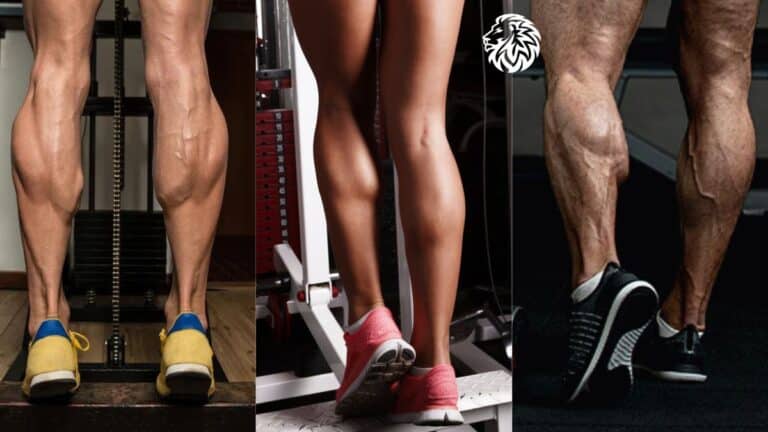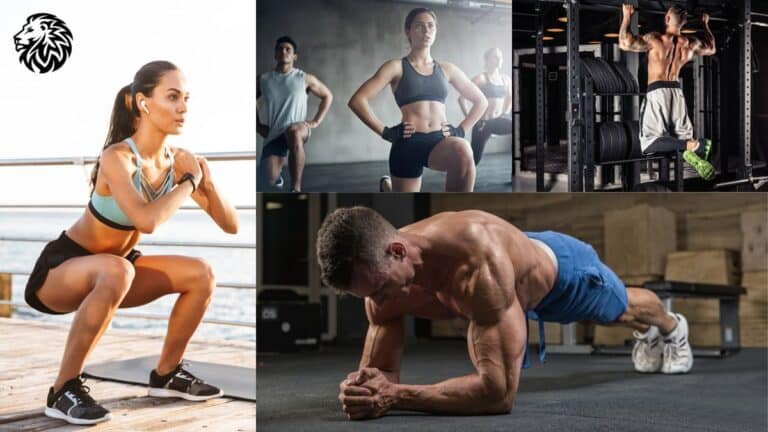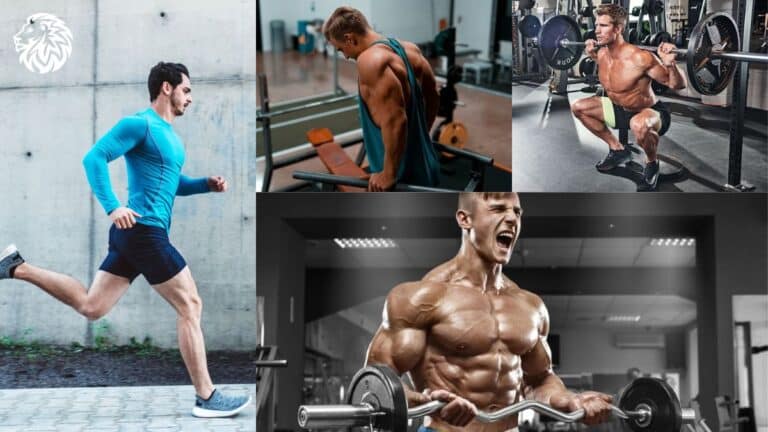Building a strong, well-defined chest is more than just a pursuit of aesthetic appeal; it’s a critical component of overall upper body strength and functionality. Chest exercises, particularly those involving the pectoral muscles, play a vital role in numerous daily activities and sports-related movements. They contribute significantly to your upper body’s pushing capabilities and overall stability.
Dumbbells, as a tool for chest workouts, offer a unique set of advantages. Their versatility allows for a wide range of motion, crucial for fully engaging the chest muscles. Unlike fixed gym equipment, dumbbells require you to balance the weight independently with each arm, promoting muscular symmetry and coordination. This aspect is essential for functional fitness, as it mirrors real-world activities where each arm often works independently. Additionally, dumbbells are ideal for home workouts, requiring minimal space while offering a plethora of exercise variations to target different parts of the chest.
In this exploration, we delve into eight quintessential dumbbell exercises designed to sculpt and strengthen your chest. Each exercise is selected for its effectiveness in targeting various aspects of the chest muscles. The lineup includes:
- Dumbbell Bench Press: A classic move for overall chest development.
- Incline Dumbbell Press: Targeting the upper chest, vital for a well-rounded appearance.
- Dumbbell Flyes: Focusing on stretching and contracting the chest muscles.
- Dumbbell Pullover: A unique exercise that works both the chest and back.
- Decline Dumbbell Press: Emphasizing the lower chest muscles.
- Close Grip Dumbbell Press: A variation that engages the inner chest and triceps.
- Dumbbell Push-Up: A compound move that strengthens the chest, shoulders, and core.
- Incline Dumbbell Fly: Perfect for hitting the upper chest at a different angle.
As we dive into each exercise, we’ll explore the proper techniques, tips for maximizing effectiveness, and variations to suit different fitness levels. Whether you’re a beginner or an experienced fitness enthusiast, these exercises offer a path to achieving a stronger, more defined chest.
The 8 Best Dumbbell Chest Exercises
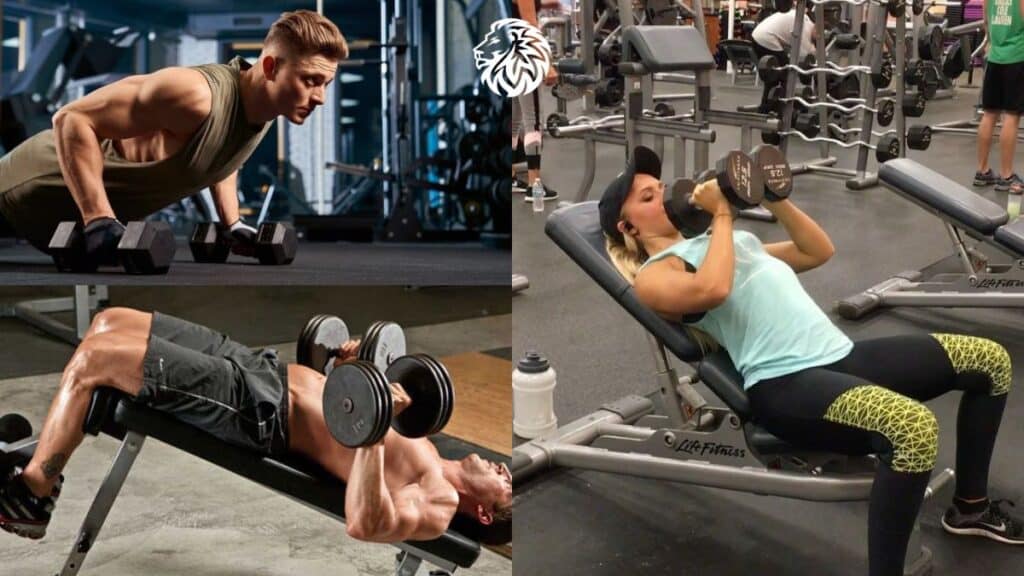
1. Dumbbell Bench Press
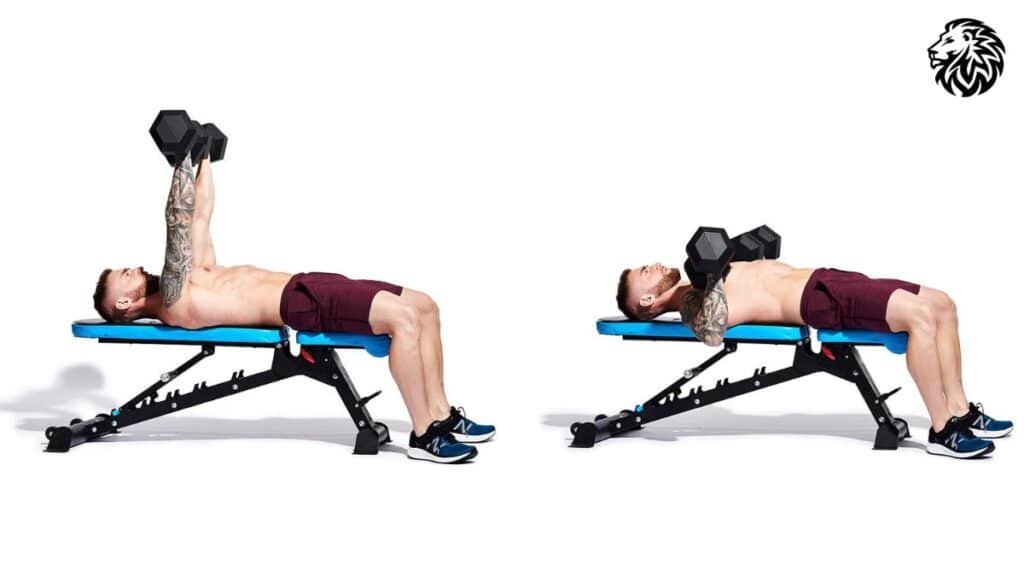
Overview
The Dumbbell Bench Press is a staple in chest workouts, renowned for its effectiveness in building strength and size. Unlike its barbell counterpart, this exercise allows a greater range of motion, providing a more comprehensive chest muscle workout.
Muscles Targeted:
- Primary: Pectoralis Major (Chest Muscles)
- Secondary: Triceps and Deltoids (Shoulder Muscles)
Technique Guide
Step-by-Step Instructions:
- Starting Position: Lie flat on a bench, holding a dumbbell in each hand at chest level. Your feet should be flat on the floor, and your back slightly arched.
- Grip and Elbow Position: Hold the dumbbells with a grip slightly wider than shoulder-width, palms facing forward. Elbows should be at a 45-degree angle to your torso.
- Lifting Phase: Exhale as you press the dumbbells upward in a smooth, controlled motion until your arms are fully extended, but not locked.
- Lowering Phase: Inhale as you slowly lower the dumbbells back to the starting position, aligning them with your chest level.
- Repeat: Perform the desired number of repetitions, maintaining control throughout the movement.
Tips and Variations
Maximizing Effectiveness:
- Ensure full range of motion for maximum muscle engagement.
- Focus on a controlled tempo; avoid rushing the movements.
- Engage your core throughout the exercise to maintain stability.
Variations for Different Skill Levels:
- Beginners: Start with lighter weights to master the technique. A flat bench is recommended.
- Intermediate: Increase the weight while maintaining proper form. Experiment with slight variations in grip width to target different parts of the chest.
- Advanced: Introduce variations such as the alternating dumbbell press, where you lift one dumbbell at a time, or incorporate a stability ball instead of a bench to engage core muscles further.
This exercise, adaptable to various skill levels, is fundamental for a comprehensive chest-building regimen. Its versatility allows for modifications to keep your workouts challenging and effective.
2. Incline Dumbbell Press
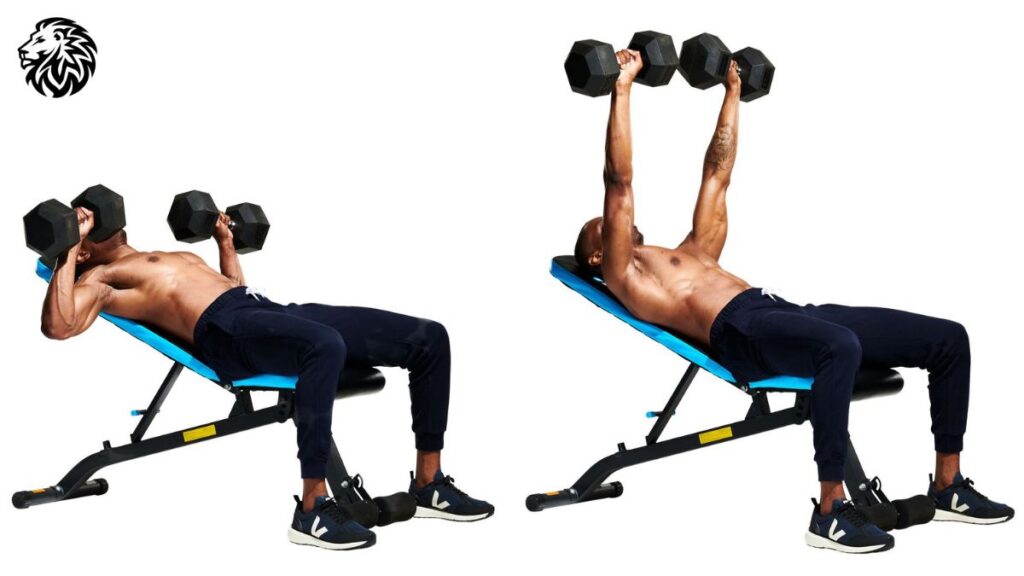
Overview
The Incline Dumbbell Press is a variation of the classic bench press that shifts the focus more towards the upper chest. This adjustment in angle provides a comprehensive chest development, ensuring that the upper pectorals don’t lag behind the larger, more dominant mid and lower chest muscles.
Purpose of Incline Position:
- Specifically targets the upper portion of the pectoral muscles.
- Helps in achieving a more balanced, proportional chest development.
- Engages the shoulders and triceps in a different angle, enhancing overall upper body strength.
Targeted Muscle Groups:
- Primary: Upper Pectoralis Major (Upper Chest)
- Secondary: Shoulders (Deltoids) and Triceps
Technique Guide
Detailed Execution Steps:
- Starting Position: Sit on an incline bench set at a 30 to 45-degree angle, holding a dumbbell in each hand at shoulder level. Feet should be flat on the floor.
- Grip: Hold the dumbbells with palms facing forward, similar to the flat bench press position.
- Pressing Phase: Exhale and press the dumbbells up over your chest by extending your arms, keeping a slight bend in your elbows at the top to avoid joint strain.
- Lowering Phase: Inhale as you slowly bring the dumbbells down to the sides of your upper chest, maintaining the angle of your elbows.
- Repeat: Complete the set with controlled, steady movements.
Tips and Variations
Safety Tips:
- Start with a weight that allows you to maintain proper form.
- Ensure the bench is securely positioned and the back is firmly against the bench throughout the exercise.
- Avoid dropping your head back; keep your spine in a neutral position.
Variations for Difficulty Adjustment:
- Decreased Difficulty: Use lighter weights and a lower incline angle. Focus on mastering the form before progressing.
- Increased Difficulty: Increase the weight while ensuring you can perform each rep with proper form. Experiment
with different incline angles to further challenge the upper chest. For advanced individuals, try using a single-arm press to increase core engagement and unilateral strength.
Incorporating the Incline Dumbbell Press into your chest routine ensures a well-rounded development of the chest muscles, particularly the often under-targeted upper pectorals. It’s a versatile exercise that can be adjusted in difficulty and intensity to suit a range of fitness levels, from beginners to advanced athletes.
3. Dumbbell Flyes
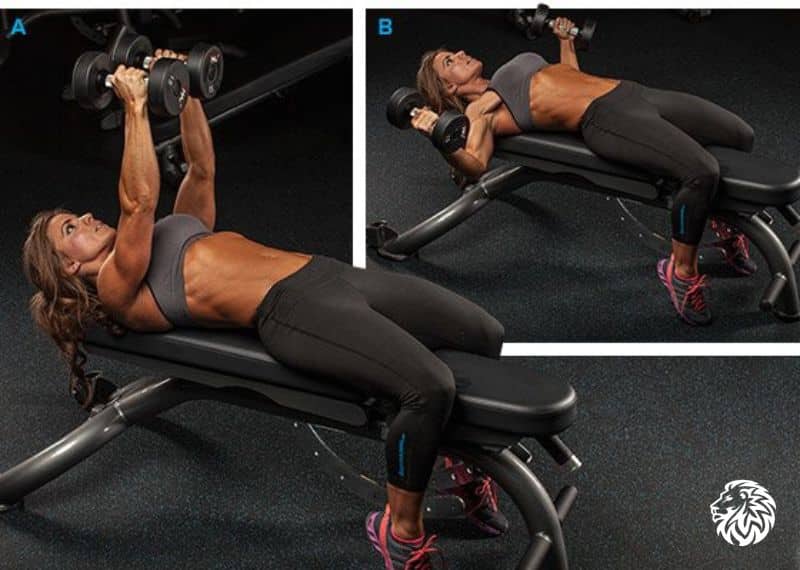
Overview
Dumbbell Flyes are a quintessential exercise for chest development, focusing on stretching and contracting the chest muscles. Unlike pressing movements, flyes isolate the pectorals by eliminating much of the triceps’ involvement, ensuring a targeted workout.
Exercise Benefits:
- Enhances chest width and definition by working on the outer pectoral muscles.
- Improves flexibility and range of motion in the shoulders.
- Offers a deep stretch that can aid in muscle growth and chest shaping.
Muscles Worked:
- Primary: Pectoralis Major (Chest Muscles)
- Secondary: Shoulders (Deltoids) and Biceps (due to stabilization)
Technique Guide
Correct Form and Movement:
- Starting Position: Lie on a flat bench with a dumbbell in each hand, arms extended above your chest. Keep a slight bend in your elbows to protect the joint – this will be your arm position throughout the exercise.
- Lowering Phase: Slowly lower the weights out to the sides in a wide arc until you feel a stretch in your chest. Keep the movement controlled, and do not let your arms drop too low.
- Lifting Phase: Bring the dumbbells back up along the same path, focusing on using your chest muscles to perform the lift.
- Breathing: Inhale as you lower the weights, exhale as you lift them.
Tips and Variations
Common Mistakes to Avoid:
- Avoid locking your elbows; keep them slightly bent to protect the joint.
- Don’t lower the weights too far; this can put excessive strain on your shoulders.
- Ensure you’re moving the dumbbells in a controlled manner, not using momentum.
Alternative Grips and Angles:
- Palm Facing In Grip: This variation changes the focus slightly on the chest muscles and can be easier on the shoulders.
- Incline or Decline Bench: Performing flyes on an incline or decline bench targets different areas of the chest, offering a more comprehensive chest development.
- Single-Arm Dumbbell Fly: This advanced variation increases core engagement and allows for focused attention on each side of the chest.
Dumbbell Flyes are a powerful tool in the chest-building arsenal, offering a unique way to stimulate the pectoral muscles differently from pressing exercises. By avoiding common mistakes and experimenting with grips and angles, you can maximize the effectiveness of this exercise.
4. Dumbbell Pullover
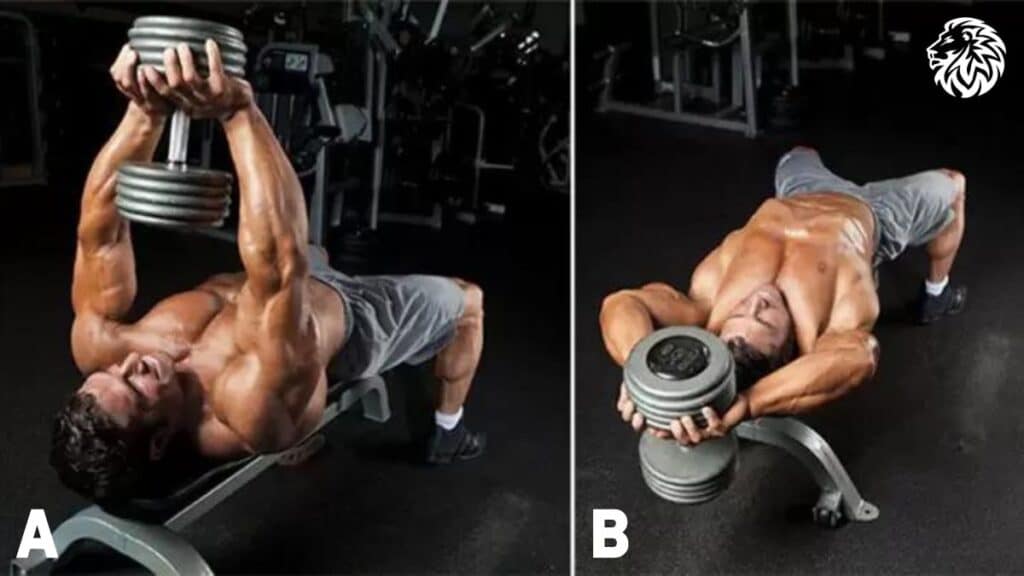
Overview
The Dumbbell Pullover is a distinctive exercise that not only targets the chest but also engages the lats, making it a versatile upper body movement. This exercise has a long history in bodybuilding for its ability to develop the chest and improve upper body flexibility and posture.
Unique Aspects of the Pullover:
- Works both the chest and back muscles, particularly the upper chest and lats.
- Enhances thoracic extension and shoulder mobility.
- Can help create the illusion of a larger, more defined chest and a smaller waist.
Targeted Areas:
- Primary: Upper Pectoralis Major (Chest) and Latissimus Dorsi (Back)
- Secondary: Triceps, Shoulders, and Serratus Anterior
Technique Guide
Step-by-Step Execution:
- Starting Position: Lie perpendicular on a flat bench with only your upper back and shoulders on the bench. Your hips should be below the bench, and feet flat on the floor.
- Holding the Dumbbell: Hold one dumbbell with both hands directly above your chest, arms extended. The dumbbell should be held in a “diamond” grip (hands forming a triangle around the handle).
- Lowering Phase: Slowly lower the dumbbell back and over your head, keeping your arms straight, until your biceps are by your ears. You should feel a stretch in your chest and lats.
- Lifting Phase: Bring the dumbbell back to the starting position, using your chest and lats to power the movement.
- Breathing: Inhale as you lower the dumbbell, exhale as you lift it back up.
Tips and Variations
Safety Considerations:
- Start with a lighter weight to ensure you can control the full range of motion.
- Ensure the bench is stable and your grip on the dumbbell is secure to prevent injury.
- Avoid dropping your hips; keep your body in a straight line from shoulders to knees.
How to Intensify the Exercise:
- Gradually increase the weight as you become more comfortable with the movement.
- Slow down the tempo, especially during the lowering phase, to increase muscle tension.
- For advanced individuals, try performing the pullover on a stability ball to engage the core muscles more intensely.
The Dumbbell Pullover is a unique and effective exercise for developing the chest and back. It requires careful attention to form and control, but when executed correctly, it can be a highly beneficial addition to your upper body routine.
5. Decline Dumbbell Press
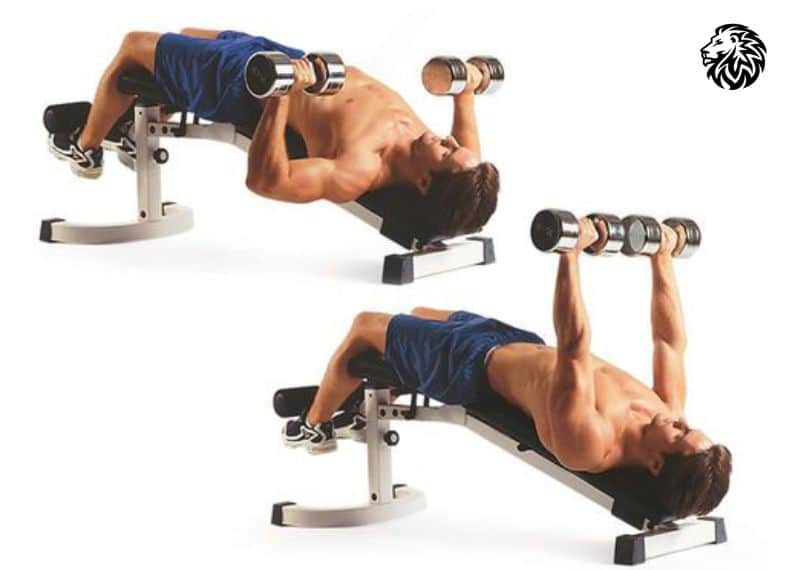
Overview
The Decline Dumbbell Press is a variation of the traditional dumbbell bench press, performed on a decline bench. This exercise shifts the focus towards the lower part of the chest, offering a comprehensive approach to chest development.
Benefits of the Decline Position:
- Targets the lower pectoral muscles more effectively than the flat or incline press.
- Can reduce strain on the shoulders and upper back, making it a suitable alternative for those with shoulder issues.
- Often allows for lifting heavier weights compared to the flat bench press, which can be beneficial for overall strength development.
Muscles Engaged:
- Primary: Lower Pectoralis Major (Lower Chest)
- Secondary: Triceps, Shoulders
Technique Guide
Proper Form and Technique:
- Starting Position: Secure your legs at the end of the decline bench and lie down with a dumbbell in each hand. Your head should be lower than your hips.
- Grip and Arm Position: Hold the dumbbells above your chest with your arms straight, palms facing away from you. Keep a slight bend in your elbows.
- Lowering Phase: Slowly lower the dumbbells to the sides of your chest. Keep the movement controlled and elbows aligned with your lower chest.
- Pressing Phase: Push the dumbbells back up to the starting position, exhaling as you lift.
- Repeat: Perform the desired number of repetitions.
Tips and Variations
Adjusting the Decline Angle:
- A slight decline (15-30 degrees) can effectively target the lower chest while being more comfortable for beginners.
- A steeper angle will increase the focus on the lower chest but may be more challenging to balance and control.
Variation for Beginners:
- Start with lighter weights to get accustomed to the movement and balance required for the decline position.
- Focus on mastering the form before increasing the weight.
- Beginners can also perform the exercise with a reduced range of motion until they build enough strength and stability.
The Decline Dumbbell Press is an excellent way to isolate and build the lower chest muscles. By adjusting the decline angle and weights, it can be adapted for various fitness levels, making it a versatile addition to your chest workout routine.
6. Close Grip Dumbbell Press
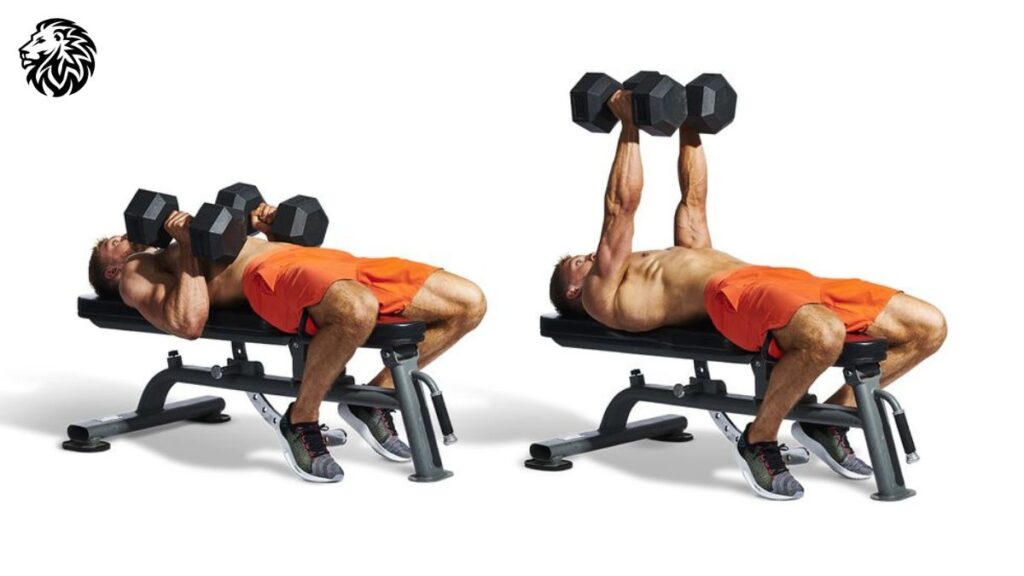
Overview
The Close Grip Dumbbell Press is a variation of the standard dumbbell press, specifically designed to target the inner chest and triceps more intensely. This exercise is pivotal for those looking to develop these areas, providing a different stimulus compared to traditional chest exercises.
Focus on Inner Chest and Triceps:
- Targets the inner pectoral muscles, which are often difficult to isolate.
- Places greater emphasis on the triceps, making it an excellent compound movement for arm development.
Exercise Specifics:
- The closer grip engages the triceps and the inner chest more than a standard dumbbell press.
- Helps in developing muscle definition and strength in the central part of the chest.
Technique Guide
Execution Instructions:
- Starting Position: Lie on a flat bench with a dumbbell in each hand. Press the dumbbells up so that they are directly above your chest, with the dumbbells touching or nearly touching each other.
- Grip: Your palms should be facing each other, and your arms should be straight up.
- Lowering Phase: Slowly lower the dumbbells towards the center of your chest, keeping them close together. Your elbows should move straight down to your sides.
- Pressing Phase: Push the dumbbells back to the starting position, fully extending your arms.
- Repeat: Perform the desired number of repetitions while maintaining the close grip.
Tips and Variations
Grip Variations:
- Experiment with slightly different grip widths to find the most comfortable position that still targets the inner chest and triceps.
- Try using a ‘diamond grip’ (fingers interlocked) for a different stimulus.
Incorporating into Routines:
- The Close Grip Dumbbell Press can be included as part of a chest or upper body workout.
- It pairs well with exercises that target the outer and upper chest to ensure a balanced chest development.
- It can also be combined with triceps exercises in an arm-focused workout.
This exercise is particularly effective for those looking to enhance the definition and strength of their inner chest and triceps. It’s important to focus on maintaining the close grip throughout the exercise and to adjust the weight accordingly to ensure proper form and prevent injury.
7. Dumbbell Push-Up
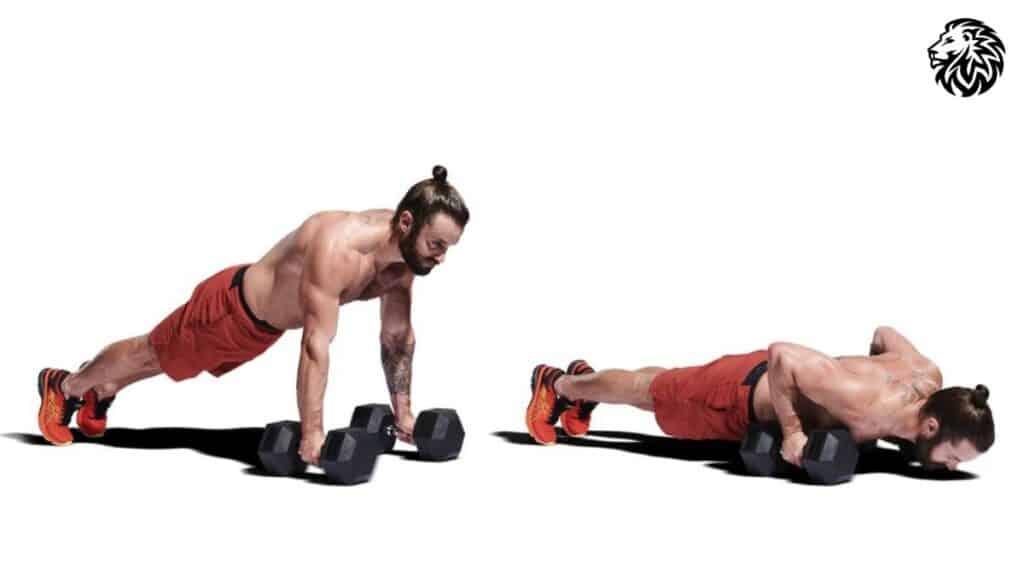
Overview
The Dumbbell Push-Up is an innovative variation of the classic push-up that incorporates dumbbells. This exercise not only intensifies the standard push-up but also adds an element of stability and grip strength training.
Combining Push-Ups with Dumbbells:
- Using dumbbells allows for a deeper range of motion, increasing the challenge and effectiveness of the push-up.
- The need to stabilize the dumbbells engages more muscle groups, particularly in the arms and core.
Targeted Muscle Groups:
- Primary: Chest (Pectorals), Shoulders (Deltoids), and Arms (Triceps)
- Secondary: Core muscles for stabilization
Technique Guide
How to Properly Perform:
- Starting Position: Place two dumbbells on the floor at shoulder-width apart. Grip the dumbbells and position yourself in a plank position, with your body forming a straight line from your head to your heels.
- Lowering Phase: Bend your elbows to lower your body towards the floor. Keep your elbows close to your body to maximize triceps engagement.
- Pressing Phase: Push through your palms to extend your arms and return to the starting position.
- Repeat: Perform the desired number of repetitions while maintaining proper form.
Tips and Variations
Using Different Dumbbell Positions:
- Parallel Position: Dumbbells are parallel to each other, which is the standard grip and focuses on the chest and triceps.
- Rotated Position: Rotate the dumbbells so your palms face each other to engage different parts of the chest and shoulders.
Adjusting Difficulty:
- Easier: Perform the exercise with your knees on the ground or elevate your hands on a higher surface (like a bench) while gripping the dumbbells.
- Harder: Add a row at the bottom of the push-up to engage your back and biceps, or perform a push-up with a hand release at the bottom for added depth and difficulty.
The Dumbbell Push-Up is a versatile exercise that can be modified to suit various fitness levels. It not only strengthens the upper body but also enhances core stability and balance, making it a valuable addition to any workout routine.
8. Incline Dumbbell Fly
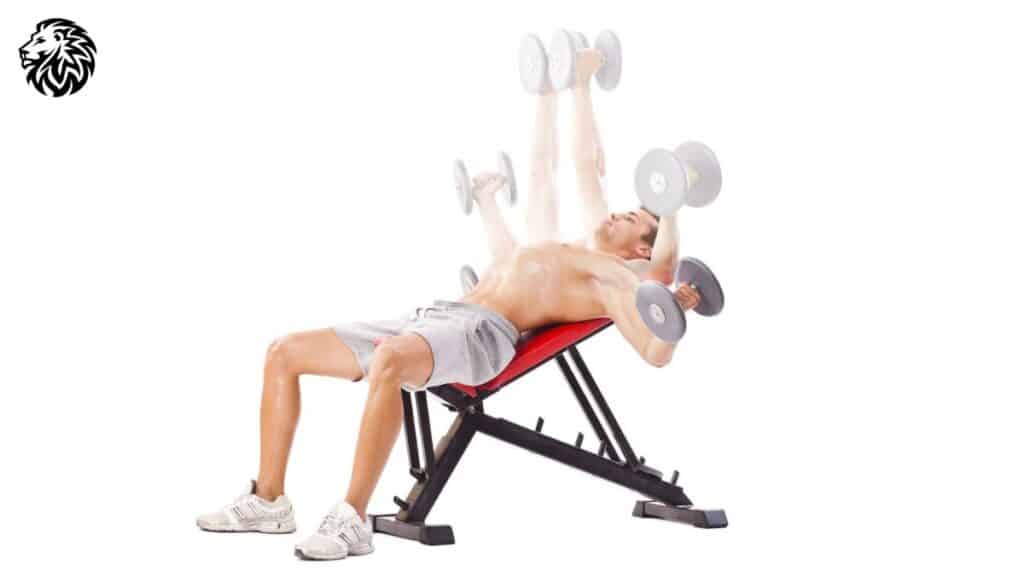
Overview
The Incline Dumbbell Fly is a variation of the traditional dumbbell fly, performed on an inclined bench. This exercise specifically targets the upper chest, providing a more comprehensive chest development with a focus on the clavicular head of the pectoral muscles.
Explanation of the Incline Fly:
- By performing the fly on an incline, the primary focus shifts from the middle chest muscles to the upper chest.
- This angle helps in developing the upper part of the pectoral muscles, which often lack in size and definition compared to the lower and middle chest.
Muscles Targeted:
- Primary: Upper Chest (Upper Pectoralis Major)
- Secondary: Shoulders (Deltoids), Arms (Biceps due to stabilization)
Technique Guide
Detailed Guide to Performing the Fly:
- Starting Position: Sit on an incline bench set at about a 30-45 degree angle. Hold a dumbbell in each hand, arms extended above your chest, with a slight bend in your elbows.
- Lowering Phase: Slowly open your arms, lowering the dumbbells in a wide arc until you feel a stretch in your upper chest. Keep the movement controlled and elbows in a fixed, slightly bent position.
- Lifting Phase: Bring the dumbbells back up along the same path, focusing on using your chest muscles to perform the movement.
- Breathing: Inhale as you lower the weights, exhale as you lift them.
Tips and Variations
Avoiding Common Injuries:
- Do not lower the dumbbells too far, as this can put undue stress on your shoulder joints.
- Ensure that the bend in your elbows remains constant throughout the exercise to avoid straining your arms.
- Start with lighter weights to perfect your form before gradually increasing the load.
Variations for All Levels:
- Beginners: Use lighter weights and a smaller range of motion. Focus on mastering the technique and understanding the muscle engagement.
- Intermediate: Increase the weight and experiment with different angles of incline to target various parts of the upper chest.
- Advanced: Incorporate pauses at the bottom of the movement for increased muscle tension, or perform the exercise with one arm at a time for unilateral development and enhanced core engagement.
The Incline Dumbbell Fly is an effective exercise for targeting the upper chest, an area often neglected in standard chest routines. By practicing proper form and gradually increasing intensity, this exercise
can significantly enhance the aesthetics and strength of the upper chest, rounding out a comprehensive chest-building program. Its adaptability for different skill levels makes it a valuable addition to any workout regimen, from beginners to advanced lifters.
Conclusion
In this comprehensive guide, we’ve explored eight pivotal dumbbell exercises, each tailored to sculpt and strengthen the chest. These exercises, ranging from the fundamental Dumbbell Bench Press to the targeted Incline Dumbbell Fly, provide a diverse and effective approach to chest training. Here’s a brief recap:
- Dumbbell Bench Press: The cornerstone of chest development, targeting the overall chest area.
- Incline Dumbbell Press: Focuses on the upper chest, enhancing the chest’s contour and fullness.
- Dumbbell Flyes: Stretches and contracts the chest muscles for width and definition.
- Dumbbell Pullover: A unique movement that works both the chest and the back, contributing to upper body strength and flexibility.
- Decline Dumbbell Press: Targets the often-underworked lower chest muscles.
- Close Grip Dumbbell Press: Emphasizes the inner chest and triceps.
- Dumbbell Push-Up: A versatile exercise that combines the benefits of push-ups and dumbbells for comprehensive chest and core strength.
- Incline Dumbbell Fly: Focuses on the upper chest from a different angle, promoting a balanced chest development.
Consistent practice and progressive overload are key to seeing results from these exercises. As you continue your fitness journey, remember that gradual increases in weight, repetitions, or variations in technique are essential for continuous improvement. Listen to your body, maintain proper form, and don’t rush the process. Over time, with dedication and perseverance, you will witness significant gains in strength, muscle development, and overall chest aesthetics.
Remember, every exercise session is a step forward in your fitness journey. Stay motivated, keep challenging yourself, and enjoy the process of building a stronger, more capable body.
References and Further Reading
- Tom’s Guide. (n.d.). 10 of the best dumbbell chest exercises. Retrieved from https://www.tomsguide.com/news/10-of-the-best-dumbbell-chest-exercises
- Men’s Health. (n.d.). Dumbbell chest exercises. Retrieved from https://www.menshealth.com/uk/building-muscle/a44828244/dumbbell-chest-exercises/
- SET FOR SET. (n.d.). Dumbbell chest exercises. Retrieved from https://www.setforset.com/blogs/news/dumbbell-chest-exercises
- SELF. (n.d.). Dumbbell chest workout. Retrieved from https://www.self.com/gallery/dumbbell-chest-workout
